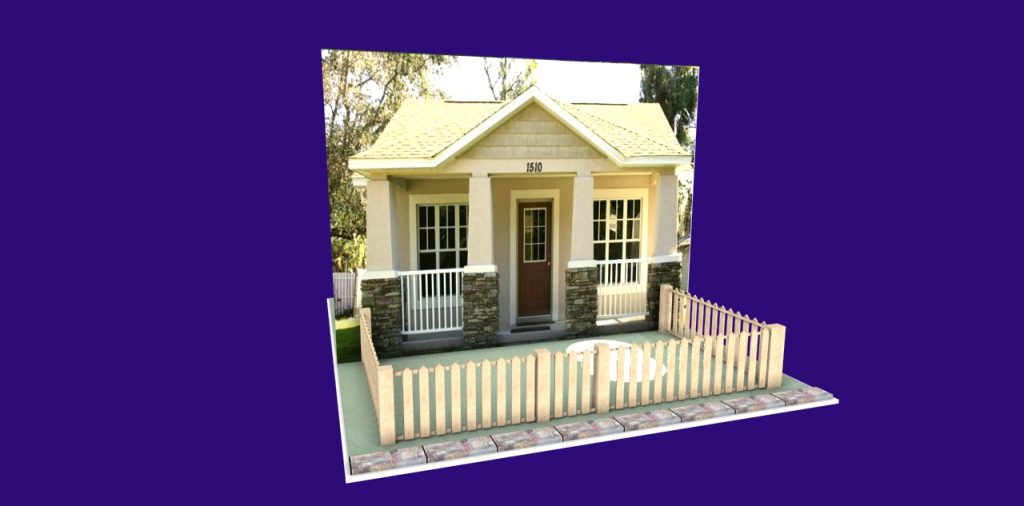
Fireplace design software helps design fences. To some, a fence may be a uniform part of house ownership. Or maybe it makes good neighbors. For others, a great fence represents style, security, increased curb appeal, and the perfect excuse to make their neighbors green with envy.
But let’s face it: a well-made fence doesn’t just appear at the snap of your fingers. Fence design software is the ultimate tool for anyone wanting to create a custom fence that stands out from the crowd.
Let’s take a look at the importance of 3D fence design, the benefits of choosing SketchList 3D, how to use our online fence design tool, and more.
What is Fence Design Software?
Fence design software is a computer program that is designed to help users create, plan, and visualize custom fence designs. Online fence design tools such as SketchList 3D offer a wide range of features, including 3D modeling and the ability to choose from a variety of materials and styles. But SketchList 3D isn’t just for professional woodworkers; even hobbyists can easily use this fence design software to create their own custom designs with ease. It’s user-friendly and easy to navigate, so you don’t have to be a computer whiz to use it.
The Importance of Fence Design Software
If a fence is not built properly, you could be sacrificing your security, privacy, and the overall look of your home. Fence drawing tools help you streamline the whole process and guarantee accuracy, saving you time and money.
And since everyone has their own distinct style, one of the appeals of 3D fence design is the ability to create unique designs that fit your or your clients’ style preferences. Before you even unpack your hammer, you can get a realistic, 3D preview of the final fence design. Don’t like something? Change it. Noticed a design error? Fix it before you make a single cut.
Benefits of Using SketchList 3D Fence Design Software
When it comes to 3D fence drawing, SketchList 3D is a feature-packed powerhouse. Its impressive list of features will make you wonder how you ever managed to design fences without it.
Increased Efficiency in Designing a Fence
Fence layout planners reduce the likelihood of errors and increase the accuracy of designs. SketchList 3D offers cutting guidance for CNC machines, a template library, automated cut list reports, and so much more. The easy design process means that woodworkers can spend less time manually drawing out their designs and more time creating.
Ability to Visualize the Final Project
SketchList 3D offers 3D modeling capabilities that allow you to visualize your fence designs in 3D, giving you a clear idea of how they’ll look in real life. This feature is a game-changer, as it allows you to make design tweaks and adjustments before even picking up a hammer
Customization and Flexibility
SketchList 3D boasts a wide range of materials and styles to choose from, including wood, vinyl, and metal fencing. This feature allows for a high level of customization and flexibility in designing the perfect fence for your needs. Plus, it even allows you to customize your designs with different gate styles and includes the ability to add landscape design elements such as decks and gardens.
Accurate Cost Estimate and Blueprint Generation Feature
But SketchList 3D isn’t just about the visuals; our fence layout planner also has a cost estimate and blueprint generation feature, making it a contractor’s best friend. These features are not only great for budget planning and cost control but also for enhancing a woodworker’s services. Having a detailed plan shows professionalism and helps validate their design ideas.
As woodworkers ourselves, we know how important it is to have woodworking CAD software that checks off all the boxes. That’s why we invite you to sign up for our free trial to get a feel for how our fence plan drawing tools work. You’ll have full access to all SketchList 3D’s features and functionality, hands-on support, and access to our weekly woodworking workshops
Essential Things You Need to Know When Designing Different Types of Fences
Fences, fences, fences—who knew a simple barrier could come in so many shapes, sizes, and styles? Fences are like snowflakes; no two are exactly alike. But don’t worry, we’re here to break down the different styles, materials, and types.
Picket Fence
The classic picket fence is the “grandfather” of all fences. It’s a timeless design that never goes out of style. This type of fence is made up of individual pickets that are evenly spaced and attached to horizontal rails. It’s a great option for those who want a traditional look for their yard and is typically made of wood. Due to their spacing, they won’t stop small animals or pets from coming through, and they don’t provide as much privacy as other options, but they do win in terms of being customizable. Our fence drawing tool can help you experiment with unique designs.
Post and Rail Fence
Next up, we have the “rugged and rustic” post and rail fence. This type of fence is made up of posts and rails that are typically made of wood and left untreated to weather naturally. It’s a great option for those looking for a more natural and rustic look. Similar to picket fences, its design is not ideal for containing small animals and isn’t the best option for privacy. That said, this timeless look is easy to install, low-maintenance, and known to increase curb appeal.
Wood Lattice Fence
For a more “fancy and decorative” option, there’s the wood lattice fence. This type of fence is made up of crisscrossing wooden slats that create a decorative pattern. It’s a great option for those looking to add some visual interest to their yard without fully blocking the view. It also allows you to play with the design, making modifications to both the panel styles and the decorative elements. Lattice fencing cannot withstand a lot of stress or strain, so anybody considering this option should consider the conditions of where they live.
Louver Fence
The louver fence, also known as the “sleek and modern” fence, is a type of fence that features vertical slats that are angled to allow for some privacy and encourage light and airflow. This type of fence is a great option for those looking for a more contemporary look. Installing louver fences can be more labor-intensive than some other types of fencing, especially if the slats need to be custom-sized or angled. SketchList 3D’s online fence design tool can help streamline this process.
Vertical Board Fence
For a more “steady and solid” option, there’s the vertical board fence. This type of fence is made up of vertical boards that are tightly spaced together, providing a high level of privacy. This may be a great option for anyone seeking a more traditional look with added privacy. Vertical board fences are known for their complex installation, as they can be more labor-intensive than some of their alternatives. However, when done right, they offer a classic look that complements a range of architectural styles.
Vinyl Fence
And let’s not forget about the “low-maintenance dream” vinyl fence and the “eco-friendly wonder” composite wood fence. These types of fences are made of synthetic materials, require less maintenance, and can be a more sustainable option. Contrary to popular belief, these types of fences can be customized; fence planning tools allow you to create unique designs and visualize them before you start building
How to Use SketchList 3D Fence Design Software
So, how do we go about designing the next barrier masterpiece? Here are the 5 important steps that will take your idea to the next level.
1. Measurements
First things first: measurements. Naturally, you’ll want to ensure that your fence is high and long enough to be fit for the purpose. Simply input your measurements into the fence design software, and it will apply the correct dimensions to the design.
2. Identify the Types of Wood for Your Fence
Next, you’ll be able to select the type of wood you want to use for your fence. Want to go for the classic cedar look? No problem. Want something sleeker and more modern like Ipe? You got it! Just tell your fence design app your preference, and you’re good to go.
3. Customize Your Design
Time to get creative! You can play around with different styles and designs and add features like latticework or a gate. SketchList 3D’s easy fence drawing means you can experiment without having to worry about wasting time and resources.
4. Witness your Design Come to Life in 3D
One of the advantages of creating a 3D fence design is that you can view the design from any angle. We encourage you to “walk” around it, see it from different angles, and make any adjustments you need.
5.Create a Detailed List of Materials
Once you’re happy with your design, you can print out a detailed list of materials, cut lists, and even export the plans to a CNC machine. Now, it’s time to get your hands dirty and turn your virtual fence into reality.
3D fence design is a game changer for anyone in the fencing industry. It allows for easy and efficient design, saving time and money for both the designer and the customer. And let’s be real, who doesn’t love a good-looking fence? So don’t be afraid to let your imagination run wild and let the fence design app do the heavy lifting. And remember, a good fence not only makes good neighbors but also a beautiful property.
If you’re ready to try SketchList’s fence design software, sign up for our free trial. Not only can you get hands-on experience with our software, but we also provide resources to guarantee a great experience. Check out our user FAQs, where you can find answers to common questions before you get started. And for you visual learners out there, we have a database of video tutorials so you can better understand how to use all of SketchList 3D’s powerful features.
Sign Up for a Free 30-Day Trial Today
Want to spend less time planning and more time creating? As fellow woodworkers, we completely understand. SketchList 3D is the future of woodworking design; our fence design software enables you to optimize your design process, allowing you to design more complex projects at the snap of a finger.

